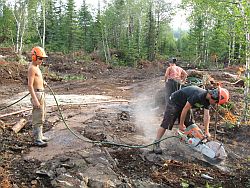 Do your homework and be transparent.
Do your homework and be transparent.
Canadian Arrow Mines Ltd. has taken the lead in working with First Nation communities organized under Grand Council Treaty 3, an area that includes 26 First Nations in northwestern Ontario and two First Nations in Manitoba.The junior miner's effort to be transparent about its exploration business has put the company ahead of the game, not only with First Nation communities, but also with other non-Aboriginal communities, cottagers and landowners."We went in immediately, talked to the folks in the area and let them know who we are and what we were up to," said Canadian Arrow president Kim Tyler, who has more than 25 years experience with companies like Teck Cominco, Northgate Minerals and Rio Tinto. Tyler applauds the receptiveness of the Treaty 3 communities, their willingness to engage with the company and understand the mining process.
Canadian Arrow Mines is in the process of earning a 100 per cent interest in the Kenbridge Nickel project, an advanced-stage nickel-copper development comprised of 85 patented and three staked mineral claims approximately 70 kilometres southeast of Kenora.
During the 1950s, Falconbridge Ltd., the previous owner of the patented claims, excavated a 2,000-foot shaft, performed 3,300 feet of horizontal development and completed 50,000 feet of surface and underground drilling. Some bulk samples were taken, but the project was left dormant by 1958 due to low metal prices. Falconbridge sold the claims in 2005.
Canadian Arrow Mines has been working with First Nation communities interested in economic development and building business relationships. A memorandum of understanding or exploratory agreement is being negotiated, which Tyler anticipates will support training and hiring First Nation people.
"That is where the government can help because there are training programs available," he said. "We would sponsor that sort of thing to get more people working with us in exploration."
Homework
Tyler and his colleagues did their homework right from the outset."I've got a book on all the communities in Canada and where they are located," he said. "We consulted with some advisors, one of them being the Canadian Aboriginal Minerals Association.
"If you are non-native, you want to be aware that the traditional lands all had to do with watersheds," Tyler explained. A watershed could be divided up among different communities, which helps determine with whom to speak. Whether by luck or by chance, Tyler's work colleagues had previous experience with First Nation groups across Canada and during a trip, spoke with one of the chiefs in the area who directed him to the appropriate individuals.
"You need to do your homework," he said. "I've had to do it, too. Everywhere you go it is a different culture and a different history."
Tyler stressed the importance of knowing the history of treaties and said he would like to see it taught in high schools to clear up some of the confusion in the non-native community and resulting conflicts that have emerged due to lack of education.
"The First Nation people are very clear on their history. They are keen nowadays and recognize their traditional lands and their rights as they are detailed in the treaties, so it is very important to give them recognition."
Communication and consultation are important in building awareness, trust, and moving forward, but Tyler said it extends beyond First Nation communities. Cognizant of the misperceptions that exist around prospecting, Canadian Arrow Mines demonstrated goodwill and transparency by hosting a series of public information sessions in an "Around the North Tour." They visited communities like Kenora, Sioux Narrows-Nestor Falls, Fort Frances, Dryden, Thunder Bay, Timmins, and Sudbury. They also arranged meetings with the local municipal leaders at each community.
"We wanted to introduce ourselves, demonstrate our accessibility and invite all the tough questions very early on before rumours and misunderstandings could happen," Tyler said. "It is a costly item but you really have to work hard to make sure people understand the risks and what you are doing to mitigate those risks."
Trying to eradicate the misperception of past mining practices is probably the company's biggest challenge, but one the team is willing to confront so people are clear on newer regulations and closure plans that enforce environmental stewardship and financial responsibility.
Best practices
- Do your homework
- Be transparent
- Education
- Demonstrate accessibility

